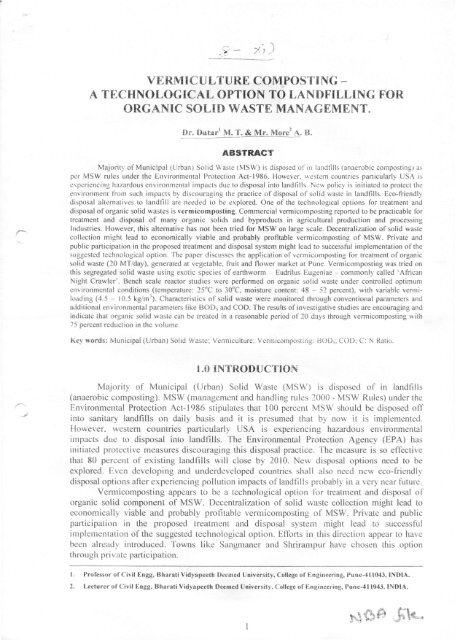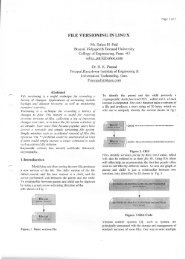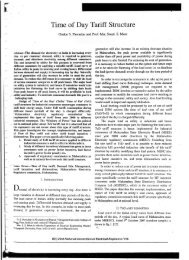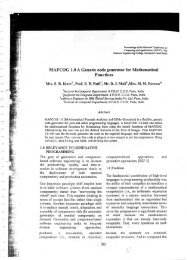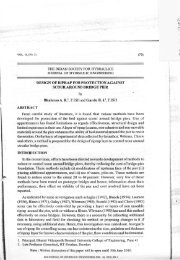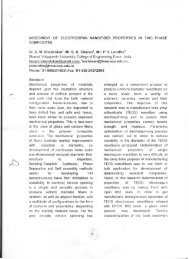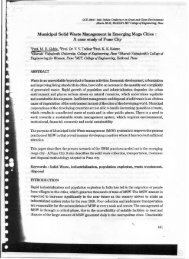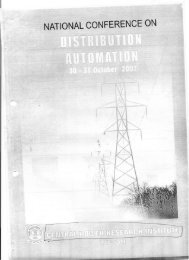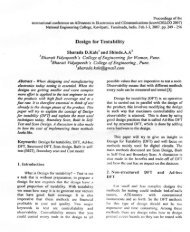Vermiculture Composting - BVU College of Engineering, Pune, India
Vermiculture Composting - BVU College of Engineering, Pune, India
Vermiculture Composting - BVU College of Engineering, Pune, India
Create successful ePaper yourself
Turn your PDF publications into a flip-book with our unique Google optimized e-Paper software.
x·-<br />
~--'<br />
. "\<br />
;Xl)<br />
VER.lVlICUL TURE COMPOSTING-<br />
A TECHNOLOGICAL OPTION TO LANDFILLING FOR<br />
ORGANIC SOLID WASTE MANAGEMENT.<br />
Dr. Oatar' M. T. & Mr. More! A. B.<br />
ABSTRACT<br />
Majority <strong>of</strong> Municipal (Urban) Solid Waste (MSW) is disposed <strong>of</strong> in landfills (anaerobic composting: as<br />
per MS W rules under the Environmental Protection Act-1986. However, western countries particularly USA is<br />
experiencing hazardous environmental impacts due to disposal into landtills. New policy is initiated to protect the<br />
environment from such impacts by discouraging the practice <strong>of</strong> disposal <strong>of</strong> solid waste in landfills. Eco-friendly<br />
disposal alternatives to landfill are needed to be explored. One <strong>of</strong> the technological options for treatment and<br />
disposal <strong>of</strong> organic solid wastes is vermicomposting. Commercial vermicornposting reported to be practicable for<br />
treatment and disposal <strong>of</strong> many organic solids and byproducts in agricultural production and processing<br />
Industries. However, this alternative has not been tried for MSW on large scale. Decentralization <strong>of</strong> solid waste<br />
collection might lead to economically viable and probably pr<strong>of</strong>itable vermicomposting <strong>of</strong> MSW. Private and<br />
public participation in the proposed treatment and disposal system might lead to successful implementation <strong>of</strong> the<br />
suggested technological option. The paper discusses the application <strong>of</strong> vermicornposting for treatment <strong>of</strong> organic<br />
solid waste (20 MT/day), generated at vegetable, fruit and flower market at <strong>Pune</strong>. Vermicomposting was tried on<br />
this segregated solid waste using exotic species <strong>of</strong> earthworm - Eudrilus Eugeniae - commonly called' African<br />
ight Crawler'. Bench scale reactor studies were performed on organic solid waste under controlled optimum<br />
environmental conditions (temperature: 25°C to 30°C. moisture content: 48 - 52 percent), with variable vermiloading<br />
(4.5 - 10.5 kg/rrr'). Characteristics <strong>of</strong> solid waste were monitored through conventional parameters and<br />
additional environmental parameters like BOD5 and COD. The results <strong>of</strong> investigative studies are encouraging and<br />
indicate that organic solid waste can be treated in a reasonable period <strong>of</strong>20 days through verrnicomposting with<br />
75 percent reduction in the volume.<br />
Key words: Municipal (Urban) Soiid Waste; vermiculture: Verrnicornposting: BOD5: COD: C: N Ratio.<br />
1.0 INTRODUCTION<br />
Majority <strong>of</strong> Municipal (Urban) Solid Waste (MSW) IS disposed <strong>of</strong> in landfills<br />
(anaerobic composting). MSW (management and handling rules 2000 - MSW Rules) under the<br />
Environmental Protection Act-1986 stipulates that 100 percent MSW should be disposed <strong>of</strong>f<br />
into sanitary landfills on daily basis and it is presumed that by now it is implemented.<br />
However. western countries particularly USA is experiencing hazardous environmental<br />
impacts due to disposal into landfills. The Environmental Protection Agency (EPA) has<br />
initiated protective measures discouraging this disposal practice. The measure is so effective<br />
that 80 percent <strong>of</strong> existing landfills will close by 2010. New disposal options need to be<br />
explored. Even developing and underdeveloped countries shall also need new ceo-friendly<br />
disposal options after experiencing pollution impacts <strong>of</strong> landfills probably in a very near future.<br />
Vermicomposting appears to be a technological option for treatment and disposal <strong>of</strong><br />
organic solid component <strong>of</strong> MSW. Decentralization <strong>of</strong> solid waste collection might lead to<br />
economically viable and probably pr<strong>of</strong>itable vermicomposting <strong>of</strong> MSW. Private and public<br />
participation in the proposed treatment and disposal system might lead to successful<br />
implementation <strong>of</strong> the suggested technological option. Efforts in this direction appear to have<br />
been already introduced. Towns like Sangmaner and Shrirampur have chosen this option<br />
through private participation.<br />
I. Pr<strong>of</strong>essor <strong>of</strong> Civil Engg, Bharati Vidyapeeth Deemed University. <strong>College</strong> <strong>of</strong> <strong>Engineering</strong>. <strong>Pune</strong>-411043, INDIA.<br />
2. Lecturer <strong>of</strong> Civil Engg. Bharati Vidyapeeth Deemed University. <strong>College</strong> <strong>of</strong> <strong>Engineering</strong>. <strong>Pune</strong>-411O·U. INOl4-.
Market Yard. Gultekdi, <strong>Pune</strong> deals with wholesale marketing <strong>of</strong> fruits, vegetables and<br />
flowers to the tune <strong>of</strong> 2500 tones per day. Market Yard collects solid waste generated and<br />
disposes it in landfills located at nearby agricultural fields. Present studies explore the<br />
possibility <strong>of</strong> using vermicomposting for treatment and disposal <strong>of</strong> solid waste. An exotic<br />
species <strong>of</strong> earthworm - Eudrilus Eugeniae - commonly called' African Night Crawler' - was<br />
used in the treatment <strong>of</strong> organic waste. The species is reported to be fast growing. ferocious<br />
eater <strong>of</strong> organic food and does not need soil substratum. Bench scaie reactor studies were<br />
performed on organic solid waste under controlled optimum environmental conditions<br />
(temperature: 25"C to 30"('. moisture content: 48 - 52 percent), with variable vermi-loading<br />
(4.5 - 10.5 kg/m '). Characteristics <strong>of</strong> solid waste were monitored through conventional<br />
parameters and additional environmental parameters like BOD5 and COD.<br />
The results <strong>of</strong> investigative studies are encouraging and indicate that organic solid<br />
waste can be treated in a reasonable period <strong>of</strong> 20 days through vermicomposting with 75<br />
percent reduction in the volume.<br />
2.0 METHODOLOGY<br />
Data regarding the generation <strong>of</strong> solid waste at Market Yard. Gultekdi. <strong>Pune</strong> was<br />
collected every day for 31 days and representative samples were analyzed in the Environmental<br />
<strong>Engineering</strong> Laboratory, to determine solid waste characteristics. After segregation into<br />
organics and inorganics, characteristics <strong>of</strong> organic component were analyzed for various<br />
parameters. Conventional parameters suggested for analysis is shown in Table l : part A.<br />
Additional parameters, BOD:; (Biochemical Oxygen Demand) and COD (Chemical Oxygen<br />
Demand) were included as performance parameters during the present studies and are shown in<br />
Table l : part B. Final results are expressed in terms <strong>of</strong> weight <strong>of</strong> parameter to weight <strong>of</strong> organic<br />
waste (converted into suspension). Tablel also gives the methods adopted for analysis <strong>of</strong><br />
various parameters.<br />
Table 1: Conventional Parameters and Methods Adopted for Analysis<br />
I Sr. No. Parameter Method I Remark<br />
I 1 2 3 4<br />
A CONVENTIONAL PARAMETERS<br />
I 01 I emperature .- Characteristics Parameter<br />
02 Moisture Content WHO Manual Characteristics Parameter<br />
I<br />
I 03 Conductivity WHO Manual Characteristics Parameter<br />
04 Kjeldahl Nitroqen IS.·10158 - 1982 Characteristics Parameter<br />
I<br />
I<br />
05<br />
06<br />
Phosphorous<br />
Potassium<br />
Standard<br />
Standard<br />
Methods<br />
Methods<br />
Characteristics<br />
Characteristics<br />
Parameter<br />
Parameter<br />
i 07 Oraenic Carbon/Carbon Standard Methods Characteristics Parameter<br />
08 pH IS: 10158 - 1982 Environmental Parameter<br />
09 C.-N Ratio Standard Methods Characteristics Parameter<br />
B. ADDITIONAL PARAMETERS<br />
i<br />
10<br />
11<br />
8005<br />
COO<br />
Standard<br />
Standard<br />
Methods<br />
Methods<br />
Performance<br />
Performance<br />
Parameter<br />
Parameter<br />
Bench scale vermicomposting reactors, each having capacity <strong>of</strong> 0.03402 m 3 (45cm X<br />
27cm X 28cm), were chosen for vermicomposting studies. All the reactor units were tilled with<br />
shredded organic component <strong>of</strong> solid waste. Varied earthworm loadings were applied into three<br />
reactors and additional one was kept as a control reactor, and their performance were<br />
monitored.
3.0 EUDRILUS EUGENIAE<br />
Many earthworm species would probably be suitable for solid waste treatment and<br />
disposal. Previous research, pertaining mainly to agricultural solid waste and environmental<br />
aspects. used the earthworm species which need soil as habitat and organic waste as nitrogencarbon<br />
source. Soil occupied about 25 to 40 percent <strong>of</strong> reactor volume. Through literature<br />
survey. visits to research centers and detai led discussions with research .vorkers helped in<br />
identifying a suitable earthworm species. Eudrilus Eugeniae. which doesn't need soil<br />
habitation, and was used in the present studies in the treatment <strong>of</strong> organic solid waste. Eudrilus<br />
Eugeniae, from family/genus .Eudrilidae ', commonly called .African Night Crawler' is<br />
reported to be fast growing, ferocious eater <strong>of</strong> organic food and it doesn't need soil substratum.<br />
Therefore it is expected to feed and grow in th3e reactor full <strong>of</strong> organic wastes without sub<br />
base soil.<br />
Biology <strong>of</strong> Eudrilus Eugeniae: The egg case in which development takes place (on<br />
introduction into culture beds) is called cocoon. In 2-3 weeks the development is completed<br />
and 3-7 young worms, 3-10 mg in weight and 3-5 nun in length. emerge out. These young<br />
worms will show rapid growth and by the time they are 6 weeks they reach productive stage.<br />
Earthworms are Hermaphrodites (bisexuals); but cross fertilization is the feature, wherein the<br />
exchange <strong>of</strong> sperms between the individuals takes place through a temporary mucilaginous<br />
tube during copulation. The fertilization takes place in cocoon. The cocoon production that<br />
commences by 6 weeks continues till the end <strong>of</strong> 3 months and worm continues to lay cocoon<br />
and after 6 months to 1 year worm can be harvested out to use as animal feed. The maximum<br />
number that can be laid under ideal conditions is about 100 cocoons by a pair <strong>of</strong> worms in 3-6<br />
months period.<br />
The worms that feed actively on organic waste assimilate only 5-10 percent and<br />
remaining is excreted out as loose granular mounds <strong>of</strong> Wormcast. Earthworms are responsible<br />
for breakdown <strong>of</strong> complex substances in the in the organic waste into simple water soluble<br />
substances. The enzymes secreted in the long intestine <strong>of</strong> the earthworm and the enzymes <strong>of</strong><br />
the symbiotic microbes in their gut cavity are responsible for this conversion. Earthworm<br />
casting (Vermicompost) contains all essential plant nutrients including micro-nutrients and is a<br />
balanced bio- fertilizer.<br />
4.00BSERV ATIONS AND DISCUSSIONS<br />
-1.1 WASTE GENERATION AND CHARACTERISTICS:<br />
Market yard, Gultekdi, <strong>Pune</strong> is systematically planned and located at about 3 km away<br />
from Swargate bus stand and one <strong>of</strong> the main market in Maharashtra, covers about 153 acres<br />
area subdivided into fruits (separate market exclusively for banana), vegetables (separate<br />
market exclusively for potato and onion) and flowers market. Materials are sorted out,<br />
auctioned, resorted accordingly to quality and size, properly packed and then carried to retail<br />
and wholesalers' market in Maharashtra and outside Maharashtra, and even exported to various<br />
countries. Total turnover <strong>of</strong> fruits, vegetables, and flowers is around 2500 tones/day and actual<br />
proportion <strong>of</strong> them varies depending upon the season and the products produced during season.<br />
The waste generated is manually collected from different points and then dropped into<br />
tractor-trolleys, which are weighed (on electronic weighing machine) and then transported to<br />
agricultural field about 25 km away from market yard and disposed <strong>of</strong> in landfills in irregular,<br />
arbitrary way. Record is kept at the market yard regarding number <strong>of</strong> trolleys carried away<br />
along with weight <strong>of</strong> solid waste in each trolley. To determine the quantity <strong>of</strong> solid waste
generated, data is collected for a month and observed to be about 18.64 MT per day (average <strong>of</strong><br />
31 days waste generation), which consists <strong>of</strong> vegetables, leaves, scalings, rotten materials,<br />
plastic papers, paper wastes and also tobacco sachets (thrown by workers chewing tobacco).<br />
wood packing wastes, and some metallic wastes (nails, packing steel strips) etc .. 20 kg <strong>of</strong><br />
average solid waste samples were collected 8 to 10 times in a day for 31 days and analysis<br />
indicates that average components <strong>of</strong> organics and inorganics are observed to be about 97<br />
percent and 3 percent respectively as shown in the Table 1.<br />
Table 2: Quantity <strong>of</strong> Solid Waste Generated at Market Yard<br />
Quantity in MT (per day) Quantity in % (per day) I<br />
I Orqanic Inorqanic Total Orcanic Inorqanic Total<br />
I 1 2 3 4 5 6<br />
I 18.07 0.57 18.64 96.99 3.01 100<br />
Characteristics <strong>of</strong> organic solid waste - conventional and additional parameters - are<br />
shown in Column 3, Table .J. BODs and COD (Environmental Parameters) values <strong>of</strong> organic<br />
solid waste were also determined and indicated in the Column 3, Table 4. These values are<br />
indicative to determine the final stage <strong>of</strong> verrnicornposting.<br />
4.2 BENCH SCALE VERMJ COi\;fPOSTliVG PROCESS:<br />
Four bench scale vermi reactors (RI. R2. R3 and Rr) were fabricated from wood. each<br />
with dimensions <strong>of</strong> 45cm X 27cm X 28cm depth and having capacity <strong>of</strong> 0.03402 m'. Small slit<br />
openings in sides and bottom <strong>of</strong> these reactors ensured aeration as well as drainage <strong>of</strong> water in<br />
turn to keep aerobic conditions in the reactor. During trial runs the rate and time <strong>of</strong> sprinkling<br />
<strong>of</strong> water was adjusted to maintain the moisture <strong>of</strong> solid waste in the range <strong>of</strong> 48 to 52 percent<br />
and temperature and pH \vere observed to get adjusted to 23 - 27°C and 7.0 - 7.2 respectively.<br />
which is within suitable range for vermiculture Eudrilus Eugeniae used in the<br />
vermicomposting studies. Organic component <strong>of</strong> solid waste (7 kg) was filled in each reactor.<br />
Earthworm loadings <strong>of</strong> OOOgm, 150gm, 250gm, and 350gm were introduced into reactors RJ<br />
(control reactor) . R2, R3 and R, respectively and their performance was observed over around<br />
four weeks.<br />
Original green/greenish colour <strong>of</strong> solid waste was changed distinctly to blacklblackishl<br />
earthy on conversion into vermicastings. Eudrilus Eugeniae ate up organic matter (greenish)<br />
and excreted vermicastings (blackish), during it's downward travel. Thus colour change also<br />
traveled downwards and indicated the progress <strong>of</strong> vermicornposting. During four weeks <strong>of</strong><br />
experimental studies the colour <strong>of</strong> solid waste in reactor RJ remained greenish i.e. original<br />
colour. However. solid waste colour in other reactors was observed to travel from top to<br />
bottom, which indicated progress <strong>of</strong> vermicoposting and also downwards travel <strong>of</strong> Eudrilus<br />
Eugeniae.<br />
Table 3, shows observations taken every day during vermicoposting process. Coloum 2<br />
and 3, respectively shows the height and the volume <strong>of</strong> organic solid waste in reactor RJ (to<br />
which no loading applied). Volume reduction <strong>of</strong> around 19 percent was observed. Depth <strong>of</strong> the<br />
organic waste is also reduced from 28 em to 22.5 em. Colour <strong>of</strong> the vermicomposting was not<br />
changed duri.ng this process period and remained greenish i.e. original colour. Reduction in<br />
volume might be due to little bit <strong>of</strong> aerobic bio-composting. Thus Coloum 4, which indicates<br />
vermicompost depth, is therefore zero.<br />
Coloum 5 and 6, respectively shows the height and volume <strong>of</strong> organic waste plus<br />
vermicompost in reactor R2 during the process. It is observed that, height and volume <strong>of</strong> the<br />
solid waste reduced with respect to time. Height reduced from 28 em to 7 em and volume was<br />
reduced by 75 percent (from 34.02 to 8.5 liters) at the end <strong>of</strong> 26 th day. Coloum 7, indicates the
I<br />
I<br />
,<br />
height <strong>of</strong> vermicompost from the top surface, <strong>of</strong> organic solid waste undergoing<br />
vermicomposting. This depth went on increasing and reached its maximum value <strong>of</strong> 7 cm on<br />
26 th day when vermicomposting was completed. Similar observations were recorded for<br />
reactors R3 and R. in Table 3. Period required to complete vermicomposting decreases with<br />
increase in earthworm loading. Fig. 1 shows relations between time required for<br />
vermicomposting versus vermiculture loading in gm/kg <strong>of</strong> solid waste. Minimum period<br />
needed for complete vermicomposting <strong>of</strong> solid waste was 20 days at vermiculture loading <strong>of</strong><br />
50 gm/kg <strong>of</strong> solid waste. Characteristics <strong>of</strong> organic waste being the same in reactors R2. R3 and<br />
Ri, final volume <strong>of</strong> vermicornpost remained same i.e. 8.50 liters or 25 percent <strong>of</strong> original<br />
organic waste (Fig 2).<br />
Table I compares characteristics <strong>of</strong> vermicompost in reactors with initial<br />
characteristics <strong>of</strong> organic solid waste. The colour <strong>of</strong> vermicompost was same in all reactors i.e.<br />
black or blackish. Environmental parameters, viz.BODs and COD were found to reduce by<br />
around 72 percent. BODs remaining in the solid waste was found to be only 0.65 kg/kg <strong>of</strong><br />
verrnicompost. This BODs might be due to the presence <strong>of</strong> little biomass in vermicomposting.<br />
N. P and K values were 3.3, 1.2 and 0.6 percent <strong>of</strong> vermicompost. C: N ratio was around 10.<br />
which is reported to be optimum value at which nutrient can be easily absorbed by the plants.<br />
Table 3: Observations during Bench Scale Vermicomposting<br />
Reactor<br />
Numbers-<br />
Earthworm<br />
Reactor Rl Reactor R2 Reactor R3 Reactor R4<br />
Loading I<br />
Reactor<br />
(gm) ~<br />
000 150 250 350<br />
Observations<br />
for ~<br />
Solid<br />
Height<br />
Waste<br />
Volume<br />
vermtcompost<br />
Depth<br />
Solid Waste<br />
Height Volume<br />
verrmcompost<br />
Depth<br />
Solid<br />
Height<br />
Waste<br />
Volume<br />
Vermicompost<br />
Depth<br />
Solid Waste<br />
Height Volume<br />
Vermicompost<br />
Depth<br />
Days "If cm liter em em liter em em liter cm em liter em<br />
1 2 3 4 5 6 7 8 9 10 11 I 12 13<br />
- . '- .-<br />
1 27.9 33.90 00 26.0 31.59 00 26,0 31.59 00 25.0 30.37 00<br />
2 27.7 33.66 00 ?4.1 29.?8 0.1 23.9 2903 0,1 23.0 27.94 0.2<br />
3 27.6 33.53 0.0 22.1 26.85 0.2 21.9 26.60 0.2 21.0 ?5.51 OA<br />
4 27.4 33.29 00 ?01 24.42 0.3 20.0 24.30 0.3 19.0 2308 0.6<br />
5 27.2 3305 0.0 18.3 22.23 0.5 18.4 22.35 0.5 17.5 ?1.26 0.9<br />
6<br />
7 ,<br />
27.0<br />
26.8<br />
32.81<br />
32.56<br />
0.0<br />
00<br />
16.9<br />
15.6<br />
20.53<br />
18.95<br />
0.7<br />
1.0<br />
16.7<br />
15.1<br />
20.29<br />
18,34<br />
0.8<br />
1.1<br />
15.9<br />
14A<br />
19.31<br />
17.49<br />
1.2<br />
1.6<br />
8 26.5 32.20 0.0 14.2 17,25 1.4 13.6 16.52 1.5 13.0 15.79 1.9<br />
9 26.3 31.95 00 12.7 15.43 1.7 12.1 14.70 1.9 11.5 13.97 2A<br />
10 26.1 31.71 00 11.7 14.21 2.0 11.2 13.60 2.2 11.0 13.36 2.7<br />
11 25.9 31.47 00 10.9 13.24 2A 10.5 P.75 2.6 10.2 12.39 3.2<br />
12 25.7 31.23 0.0 10A 12.63 ?8 10.0 12.15 3.0 9.9 1202 3.6<br />
13 25.5 30.98 0.0 10,0 12.15 3.1 9.6 11.66 3A 9.2 11.17 4.1<br />
14 25.2 30.62 00 9.5 11.54 3.5 9.1 11.05 3.9 8.3 10.08 4.5<br />
15 25.0 30.38 0.0 9.1 11.05 3.8 8.8 10.69 4.3 8.2 9.96 5.0<br />
16 24.8 30.13 0.0 8.6 10.44 4.0 8.5 10.32 4.6 7.8 9.74 SA<br />
17 24.5 29.77 00 8A 10.20 4.3 8.3 10.08 4.8 7.6 9.23 5.7<br />
18 24.3 29.52 00 8.2 9,96 4.5 8.1 9.84 5.0 7.5 9.11 6.1<br />
19<br />
21<br />
24.1<br />
23.9<br />
23.6<br />
29.28<br />
2904<br />
28.67<br />
0.0<br />
0.0<br />
0.0<br />
8.0<br />
7.9<br />
7.7<br />
9.72<br />
9.59<br />
9.35<br />
4.8<br />
5.0<br />
5.3<br />
7.8<br />
7.6<br />
7.4<br />
9A7<br />
9.23<br />
8.99<br />
5.5<br />
5.9<br />
6.3<br />
7.3<br />
..-<br />
8.86<br />
. --<br />
---<br />
6.6<br />
..-<br />
22<br />
24<br />
23.3<br />
?3.1<br />
22.9<br />
28.31<br />
2807<br />
27.82<br />
00<br />
00<br />
0.0<br />
7.5<br />
7.4<br />
7.3<br />
9.11<br />
8.99<br />
8.86<br />
5.6<br />
5.8<br />
6.?<br />
7.?<br />
-<br />
---<br />
8.74<br />
..<br />
---<br />
6.7<br />
-<br />
...<br />
...<br />
_.-<br />
---<br />
...<br />
---<br />
---<br />
---<br />
..-<br />
_.-<br />
25<br />
Percent<br />
Volume<br />
22.7<br />
22.5<br />
27.58<br />
?7,34<br />
00<br />
00<br />
7.2 8.74 6.6 _..<br />
---<br />
...<br />
...<br />
---<br />
---<br />
..-<br />
-_.<br />
--<br />
...<br />
---<br />
_.-<br />
19.64 75.015 75.015 75.015<br />
Reduction'<br />
Note: * - Percent Volume Reduction on completion <strong>of</strong> vernucompostmg process.<br />
5<br />
_.<br />
-<br />
I
30<br />
25<br />
26<br />
23<br />
o 21.43 35.71 50<br />
verrmcouuee Loading mgm/kg<strong>of</strong> Sohd'AaSle<br />
Fig 1: Relations between Time required<br />
for Vermicomposting versus <strong>Vermiculture</strong><br />
Loading in gmlkg <strong>of</strong> Solid Waste<br />
20<br />
40<br />
35<br />
30 ----------- --_._----<br />
25<br />
20<br />
15<br />
10<br />
5<br />
a<br />
--ReactorRl<br />
a 2 4 6 8 10 12 14 16 18 20 22 24 26<br />
Fig. 2: Volume Reduction (mJ) vis Time (days) during<br />
Vermicomposting<br />
Reactor q2<br />
Frnal Volume<br />
Table 4: Characteristics <strong>of</strong> Market Yard Organic Solid Waste, in R1 (Control Reactor - at the end<br />
<strong>of</strong> ze" day) and <strong>of</strong> Vermicompost in R " R21R3 (on completion <strong>of</strong> process)<br />
! Sr.<br />
I No.<br />
Parameters Market<br />
Yard Control Reactor R, Reactor R2<br />
Vermicompost<br />
Reactor Rl Reactor R.<br />
i<br />
Organic<br />
Solid Waste<br />
Values Percent<br />
Reduction<br />
, Increase<br />
Values Percent<br />
Reduction<br />
I Increase<br />
Values Percent<br />
Reduction<br />
I Increase<br />
Values Percent<br />
Reduction<br />
Iincraase<br />
1 2 3 4 5 6 7 8 9 10 11<br />
01 pH 7.2 7.1 -- 7.1 -- 7.0 -- 7.0 ---<br />
02 Conductivity (ms/cm) 0.764 0.650 -14.92 0.475 -37.83 0.485 -36.52 0.467 -38.87<br />
03 Moisture Content (%) 84.29 63.45 --- 62.81 --- 48.17 --- 64.36 ---<br />
04 Organic Carbon / 48.89 42.81 -12.44 32.81 -32.89 32.85 -32.81 3309 -32.32<br />
Carbon (%)<br />
I 05 COD (kg/kg) 3.50 3.10 -11.43 0.98 -72.00 0.98 -72.00 0.98 -72.00<br />
06 BODs (kg/kg) 2.40 2.05 -14.58 0.65 -72.92 0.65 -72.92 0.65 -72.92<br />
07 Kjeldahl Nitrogen (%) 4.5 4.1 -8.89 3.3 -26.67 3.3 -26.67 3.3 -26.67<br />
08 Phosphorous (%) 0.40 0.70 +75 1.20 +200 1.20 +200 1.20 +200<br />
09 Potassium (%) 0.20 0.35 +75 0.60 +200 0.60 +200 0.60 +200<br />
10<br />
I 11<br />
C: N Ratio (%)<br />
Colour<br />
10.66<br />
Greenish-<br />
10.44<br />
Greenish<br />
>10 9.94 '" 10<br />
Blackish':<br />
9.98 ::: 10<br />
Brackish"<br />
1003 :::10<br />
Blackish':<br />
Note: # - Green colour indicates fresh solid waste under cornpostmg and no change In original colour <strong>of</strong> solid<br />
waste in Reactor RI.<br />
f - Black colour indicates completion <strong>of</strong>vermicomposting process in reactors R~.R3and R.j.<br />
5.0CONCLUSION<br />
Eudrilus Eugeniae is suitable venniculture for vennicomposting <strong>of</strong> organic solid<br />
waste. Eudrilus Eugeniae doesn't require soil for habitation, thus reducing the volume <strong>of</strong><br />
vermin-reactor. Important results <strong>of</strong> presented studies are displayed in Table 5.<br />
T. abl e 5 Resu Its 0f Bench ScaIe vermtcompostinq at a GJance<br />
Sr. Item Reactor Number<br />
No. R, R2 R3 ~<br />
1 2 3 4 5 6<br />
01 Orqanic Solid Waste l.oadinq. kq / Reactor. 7.00 7.00 7.00 7.00<br />
02 Earthworm Loadinq, qrn / Reactor. 000 150 250 350<br />
03 Earthworm Loadinq, kq / rn" 000 4.41 7.35 10.29<br />
04 earthworm Loading, gm / kg <strong>of</strong> solid waste. 000 71.43 35.71 50.00<br />
05 Period <strong>of</strong> Vermicomposting, days. »> 26 26 25 20<br />
06 Initial Volume, m'''' 34.02 3402 34.02 34.02<br />
06 Final Volume, m~" 27.34 8.50 8.50 8.50<br />
07 Percent Volume Reduction. 19.64 75015 75015 75015<br />
..<br />
Note: ¥ - Initial volume: <strong>of</strong> Market Yard organic solid waste m-situ In the reactors.<br />
E - Final Volume: <strong>of</strong> biocompost I vermicompost on completion <strong>of</strong> process.<br />
6<br />
I
Vegetable / fruit / flower market solid waste can be converted into vermicompost in<br />
minimum period <strong>of</strong> 20 days with maximum volume reduction <strong>of</strong> 75 percent at a vermiculture<br />
loading <strong>of</strong> 50 gm / kg <strong>of</strong> solid waste. BOD5 and COD appear to be promising parameter for<br />
monitoring progress <strong>of</strong> vermicomposting.<br />
REFERENCES:<br />
I. APHA, A WWA. \-VPCF. "Standard Methods for Examination <strong>of</strong> Water. \\ astewater and Sludges." 16'"<br />
Edition. 1987.<br />
') Dominguez, 1., Edwards. CA. and Subler S.," A Comparison <strong>of</strong> Vermicomposting and <strong>Composting</strong>."<br />
BiocycLe,April 1997. Pp.57-59.<br />
3. Datar, M.T., Rao, M.N. and Reddy S., "Vermicornposting - A Technology Option for Solid Waste<br />
Management," Journal a/Solid Waste Technology and Management (USA). Vol. 24, No.2, May 1997, Pp 89-<br />
93.<br />
4. I. S.: 9325-1979, "Methods for Physical Analysis and Determination <strong>of</strong> Moisture in Solid Wastes," <strong>India</strong>n<br />
Standard Institution. Ne« Delhi. 1979.<br />
5. I. S.: to 158-1982. "Methods <strong>of</strong> Analysis <strong>of</strong> solid Wastes," <strong>India</strong>n Standard Institution, New Delhi. 1982.<br />
6. Kubra Bano, Kale, Radha D. and Gajanan, G.N., "Culturing <strong>of</strong> Earthworm Eutrilus Eugeniae for Cast<br />
Production and Assessment <strong>of</strong> Wormcast as Bi<strong>of</strong>ertilizer,' Soil Biology Journal, pp.98-104, Sept.. 1987.<br />
7. Mishra, K.K., "Solid Waste Management in <strong>India</strong>:' Journal <strong>of</strong>the IPHE, india, Volume No.3, 1984.<br />
8. Reinecke, A.J.. and Viljoen. S.A., .• Reproduction <strong>of</strong> the African Earthworm. Eudrilus Eugenic<br />
(Oligochaeta) - Cocoons:' Biology and Fertility <strong>of</strong>Solils Journal. South Africa, 1988. pp. 23-~7.<br />
9. Riggle.David, "Vermicomposting Research and Education," Biocycle, May 1998, Pp 54-56.<br />
10. Tchobonogluous, G., et.al. ... Solid Wastes - <strong>Engineering</strong> Principals and Management Issues." International<br />
Students Edition, McGraw HiU- Kogakusha Ltd., Tokyo, 1977.<br />
II. Viljoen, Sophie A. and Reinecke, A.1., "Life Cycle <strong>of</strong> the African Night Crawler, eudrilus Eugeniae<br />
(Oligochaeta)," South Africa, Journal Zoology, 1989, Pp, 27-32.<br />
7


